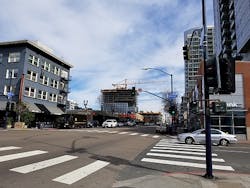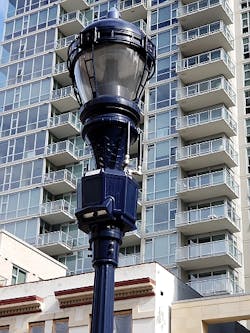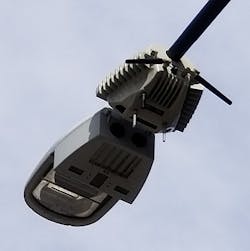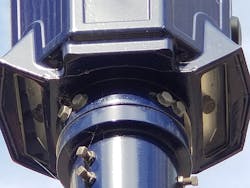The city of San Diego, CA is currently deploying what is arguably the largest smart city and Internet of Things (IoT) project yet to be undertaken globally by a municipality. Already the city has deployed 2000 smart nodes based on technology from Current, powered by GE and Intel, and the size of the network should double by mid-2019. Some of the software and applications might still be described as trials or prototypes, but the project is a full-fledged, city-wide deployment with the nodes mounted on selected LED street light poles (Fig. 1) upon which the city had previously installed solid-state lighting (SSL) with integrated wireless connectivity. The new smart nodes include cameras and other sensors, connected via high-speed cellular technology, that are capturing anonymized data which the city will use to better serve citizens and visitors. That data will also be available to organizations and businesses located in San Diego.
Before we dive into what the connected system can do for the city, let’s consider the statement characterizing the San Diego project as the largest smart city project in the world. It’s a hard claim to prove or disprove. There are far broader deployments of smart street lights that use connectivity to control lights (on, off, and dim level) programmatically or autonomously to optimize energy savings, thereby reducing costs. Likewise, such systems can streamline maintenance, again reducing costs. Los Angeles has installed more than 100,000 street lights, with a large number connected via Signify (formerly Philips Lighting) technology. The greater Miami area has an even larger connected portfolio, although fewer of the lights have been retrofitted to LED sources.
The difference in the case of San Diego is the complexity and capability of the smart nodes that Current calls CityIQ. We covered that technology related to a trial project in Portland in the summer of 2018. The nodes are supported by the partnership of Current, Intel, and AT&T Wireless. Intel supplies the microprocessor and IoT stack. AT&T handles the wireless connectivity. And Current designed the nodes, developed the cloud control and storage, and manages the system operation as a service.
The nodes include sensors that can detect things like air quality, temperature, wind speed, and more alongside forward- and rear-facing video cameras. Unlike the Portland project, the San Diego project was launched with a city-wide scope. Erik Caldwell, San Diego deputy chief operating officer for smart sustainable communities, said that 2000 nodes of an initially planned 3300 nodes have been installed. Areas of the city south of Freeway 52 have the lights installed. After the initial launch, the city subsequently added plans for another 1000 nodes. So the remaining 1300 nodes from the original contract and the additional 1000 will be installed by mid-year, according to Caldwell.
Now there remains a difference between a street light network such as the one in Los Angeles and a smart city network such as the new one in San Diego. San Diego actually has both. The CityIQ nodes in San Diego are installed on street light poles but are connected via the aforementioned cellular link. Meanwhile, San Diego has deployed 14,000 street lights that are connected with Current LightGrid mesh-networking technology. The CityIQ nodes are installed on select poles in San Diego adjacent to the LED luminaires but don’t directly rely on or interact with the luminaires. Rather, the CityIQ nodes just rely on the street light pole for mounting height and electrical power.
The prevailing wisdom has been that municipalities would install connected LED street lights, investing the money into connectivity and controls to maximize energy savings. Having invested that money, the municipality could then layer on other smart city applications. And certainly some cities are following that roadmap with connected luminaires capable of providing some level of traffic monitoring or environmental monitoring. The video capabilities in the San Diego network, however, would need a higher-speed wireless link than a technology such as LightGrid could offer; 4G mobile networks offer the needed bandwidth and emerging 5G systems will be even better.
When asked about building applications onto the existing LightGrid system and leveraging that investment, compared to deploying a second network, Caldwell was quick to say he didn’t view the new project in those terms. Instead, he said the savings from the installation of the 14,000 LED street lights made it possible for the city to invest in the second smart-city project. See the sidebar on p. 36 for some new aspects to the original LED street light project.
Deployment details
Moving back to the details of that project, the nodes are installed as densely as one CityIQ node every 100 ft in areas such as downtown San Diego and less densely in some other areas. San Diego is known for its Gaslamp district downtown and the ubiquitous acorn-style, historic-looking luminaires. The CityIQ node mounts below the luminaire on such decorative poles (Fig. 2). On traditional cobrahead street lights, the node is placed at the end of the mounting arm from the pole just before the luminaire (Fig. 3). In all cases, the installation affords the dual cameras a 360° field of view (Fig. 4). On some of the decorative poles, there are two acorn-style luminaires affixed to the pole. In such cases, the smart node is installed on the luminaire located nearer the street and the other luminaire sits atop a dummy smart-node chassis (Fig. 5).
FIG. 2. On the acorn-style street lights in the Gaslamp district, the CityIQ nodes are installed between the top of the pole and the LED luminaire. You can see the radio antennas protruding just at the top of the node near the base of the luminaire.
Indeed, any given pole has the ability to monitor the sidewalk behind the pole and the street area in front of the pole. In the case of narrow streets, the camera may even be capable of monitoring the opposite side of the street and sidewalk. In other cases, the poles on the opposite side of a wider street may have CityIQ nodes as well.
The installation and commissioning of the nodes is quite complex — far more so than installing and commissioning a basic smart street light. We have written about how utility Georgia Power relies on a GPS radio in luminaires and configuration settings stored in an LED driver to make commissioning of smart LED street lights a plug-and-play process. That capability has been supported by Current as well as other LED luminaire vendors.
The cameras in the San Diego nodes, however, greatly complicate the commissioning process, perhaps for reasons that aren’t initially obvious. Caldwell explained that the installation must acknowledge the concept of curtilage — a concept traced to old English common law. The cameras cannot capture any data/activity associated with private property. The cameras are used to capture activity on the public right of way including sidewalks and streets but not in private buildings or even in a privately-owned parking lot.
FIG. 3. On cobrahead street lights, the CityIQ nodes attach to the mounting arm extending from the pole just behind the LED luminaire.
The crew installing each camera must determine the precise longitude and latitude for the point on a surface from which the camera would capture each pixel of data. The so-called geocoding is used to essentially block pixels that would be associated with private property from being recorded.
Smart city applications
Having completed 2000 such installations and counting, you may ask, “What has the city of San Diego done with the data?” It’s currently capturing raw data such as the number of cars and pedestrians passing a node as well as environmental data. Caldwell said the goal is to determine “how can it help us better run the business of San Diego?”
The city is building basic apps and working with some partners in the Current ecosystem. Current, in a press release on the project, identified Genetec, Xaqt, ShotSpotter, and CivicSmart as possibly working with the city.
Caldwell would not discuss the details of what any third parties might provide but highlighted parking optimization as a sure target. He said the city hopes to be able to achieve 80% utilization rates for its parking space portfolio. San Diego had tried to track utilization via enforcement personnel, sensors on meters, and transactions processed by credit-card companies. But such methods could not discern instances where one car might have left before paid time in a space had expired or whether another car took that paid-for space. The camera sensor data is far more accurate. Using traditional methods, San Diego feared that utilization rates were as low as 60%, but the cameras verified that rates had approached 90% in some locations.
FIG. 4. Cameras are located on either side of the smart node, enabling the city to capture a 360° field of view — meaning both the sidewalk and street area.
Still, the potential is far greater. Caldwell said, “We are building some applications in-house that can make data available to many different executives in the city.” Perhaps more significantly, the data will be available to local organizations and even commercial businesses. In our smart lighting coverage, we’ve regularly pondered who will own the data in IoT-connected SSL scenarios. In San Diego, it appears it will be shared for the benefit of the community.
For example, Caldwell was approached by the director of a museum located in Balboa Park. That central park was once the home of a world’s fair and houses the famous San Diego Zoo, more than a dozen museums, and other attractions. The museum director wanted to know if he could access the pedestrian traffic passing by for comparison with the number of actual visitors. Caldwell’s organization will be able to service such requests via APIs (application programming interfaces).
Anonymous data
We asked Caldwell about the logistics of such cooperation, especially with respect to privacy regulations and even the impact on the IoT system. Caldwell said, “The good thing about the Current node is that the data coming off the street light node is anonymized.” There is no inherent ability to do facial recognition or license plate recognition. Caldwell added, “There is nothing in here that will allow you to play that ‘Big Brother’ role.”
FIG. 5. Some of the gaslamp-style poles have dual LED luminaire heads. As the image shows, the antennas are present on the node under the luminaire on the right. The luminaire on the left sits atop a dummy node chassis. The next double-luminaire pole just up the street may have no node installed and, in such a case, the luminaires mount directly to the pole at the height of the central decorative element atop the pole.
Still, we wondered about using the cameras to detect crime. Caldwell replied, “We never deployed this system with law enforcement as its intended use.” Caldwell did admit there would be instances in which footage could be used by police in the case of a major crime.
Caldwell said, “If you have information that can likely solve a crime, you are obligated to provide it.” The individual nodes store five days of video footage. And in such exceptional criminal cases, the police could turn to Current to retrieve the actual video footage. But Caldwell said his office had no access to such original footage. He also noted that there is no provision in the system for extending the five-day storage period or for violating curtilage concepts.
Meanwhile, organizations such as the Balboa Park museum gain valuable insight into traffic patterns. The sporadic access of such data has no impact on the bandwidth or processing power of the system. Caldwell proclaimed, “What’s game changing is when organizations find ways to use the data.” He added, “It’s new data. And it’s good data.”
Smart city goals
Looking forward, Caldwell again emphasized that the guiding idea was city-wide deployment from the start. He projects that the data will help with urban planning, traffic engineering, special event impact and success, and many other facets that deliver positive benefits for the community and its citizens.
Still, San Diego has a checkered past with respect to some urban projects such as street repair. The city was impacted by the market crash a decade ago and a pension fund that was not managed properly. Those realities have long impacted the city’s ability to invest in infrastructure. At first glance, the city, while a top tourist draw with great year-round weather, might not have been expected to pioneer smart-city technology.
We asked Caldwell if the fact that LED street lights first, and the smart-city project second, garnered municipal funding and support because of the payback or return on investment potential. “That’s what makes this easy,” said Caldwell. “But it’s a technology that helps us do all of the other things better.”
For example, Caldwell mentioned potholes in streets. He said the city hoped to use the cameras to monitor the condition of the streets. He expects to be able to use artificial intelligence (AI) to automatically detect potholes and alert maintenance crews or even to detect a pothole in the making. He expects there will be applications in tree and landscape maintenance and for spotting trash issues.
Promise Zones
One final differentiator for the San Diego project comes in where the technology will be deployed first and foremost. The city is focused first on Promise Zones — a federal designation for high-poverty communities where the federal government works with local officials to increase economic activity.
Caldwell said San Diego is committed to rolling out new applications in Promise Zones first. He said it’s more typical that wealthier neighborhoods get access to new municipal technology first. But the opposite will happen in the ongoing smart city project.
Looking back at first the LED street light deployment and then to the subsequent smart city project, Caldwell concluded, “That’s been exciting for us. And we hope it can be used as a model.”
Energy metering in LED luminaires compounds savings
While the main article here was focused on advanced smart-city technology and applications, San Diego also continues to improve its financial bottom line relative to energy costs. Indeed, when Current, powered by GE announced key milestones for the smart city project back in November, the company combined news about new energy metering in the connected street light portfolio totaling 14,000 luminaires.
Having energy-use or power meters in luminaires is not a new concept. But as we have written in the past in coverage from the Illuminating Engineering Society (IES) Street & Area Lighting Conference (SALC), utilities have questioned the accuracy of integrated meters. Of course, the utilities might also prefer the ease of set tariffs and the fact that such tariffs were generally higher than actual usage. Moreover, managing the actual usage data flow was a logistics headache.
Erik Caldwell, San Diego deputy chief operating officer for smart sustainable communities, said the city was working with utility San Diego Gas & Electric (SDG&E) and it took several years to move to accurate metering. He said connected LED luminaires installed across the city have had the metering capability since they were installed.
Indeed, it was a joint statement by Current and SDG&E that announced the new capability. The duo said they undertook a six-month joint software development project to enable the metering. The software enables the Current LightGrid system to automatically interface with and transfer power usage data to SDG&E’s billing system.
San Diego projects that the metering of energy use will result in a further reduction of $25,000 per year in expenses for street light power. “SDG&E’s use of third-party meter data was new but coupling that capability with a consumption-based concept is pioneering,” Caldwell said. “It is gratifying to continue to see our teams delivering solutions that directly benefit the communities we serve.”
—Maury Wright









